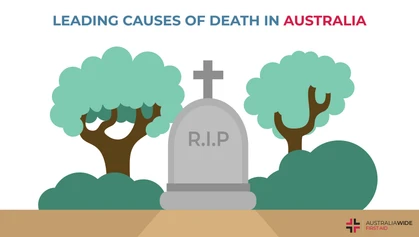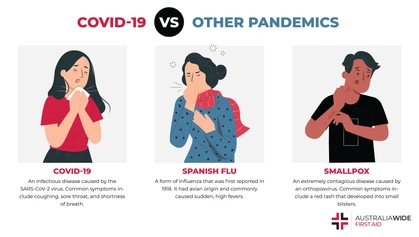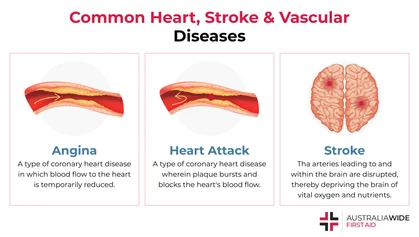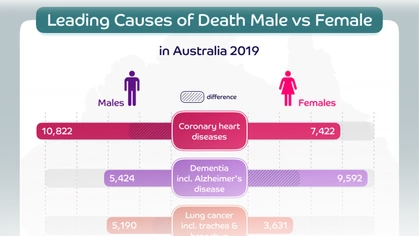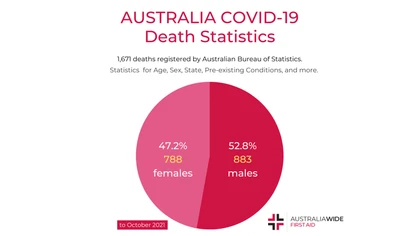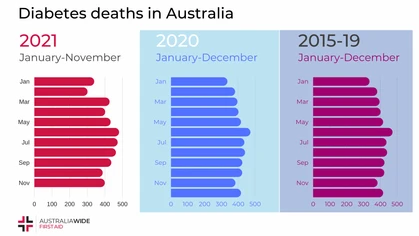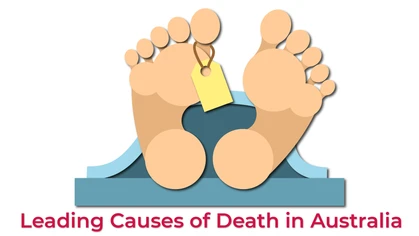Chronic Respiratory Conditions

Health Statistics
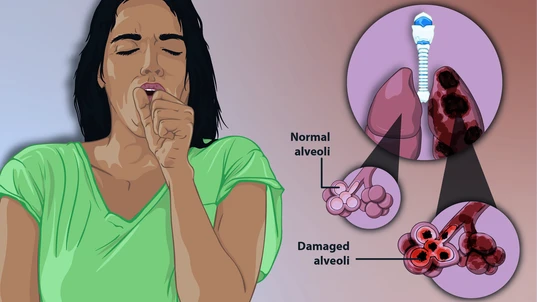
Depiction of a woman suffering from Emphysema, a type of Chronic Obstructive Pulmonary Disease.
Respiratory diseases affect the lungs and airways – all the passages through which air travels from the mouth and nose to the lungs. This can be chronic (long lasting) or acute (short term). Respiratory diseases, such as pneumonia, influenza, and chronic lower respiratory diseases (including emphysema and chronic bronchitis), cause ill health and disability. They can also cause death.
Tracking respiratory diseases
This article does not include deaths due to COVID-19. Tracking respiratory diseases through the pandemic has shown increased mortality from pneumonia in some countries, indicating some misclassified COVID-19 mortality. Many acute respiratory diseases (including influenza and some types of pneumonia) are transmitted via droplets. Measures to prevent the spread of COVID-19 also reduce the spread of other communicable diseases. In Australia, 12,053 deaths from respiratory diseases were recorded between January and November 2021. This is 8.4% higher than 2020 (11,114), but 1,297 deaths (9.7%) below the 2015-19 average. It's reasonable to conclude COVID measures contributed to the lower number of deaths in 2020 and 2021. In November 2021 there were 962 deaths due to respiratory diseases – 5.4% more than in November 2020, but 9.9% below the 2015-19 average. There was a 23.9% decrease in the age-standardised death rate from respiratory diseases. With a drop of 45.8% from 2019, influenza and pneumonia mortality decreased more than other respiratory diseases. The decrease in the respiratory disease death rate from 2019 is the largest recorded over the past 10 years.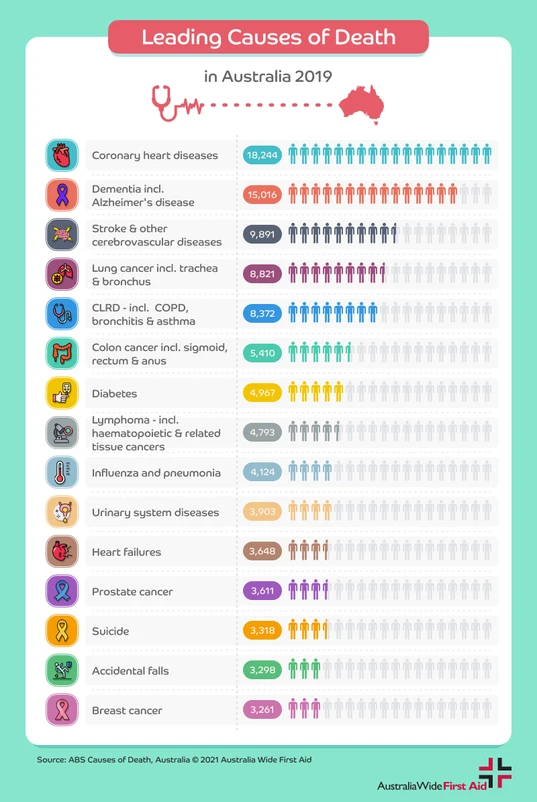
Australia's leading causes of death in 2019
Chronic lower respiratory diseases
Chronic lower respiratory diseases include chronic bronchitis, emphysema, asthma, and chronic obstructive pulmonary diseases. In 2020, the top 5 leading causes of death were the same as in 2019:- Ischaemic heart disease
- Dementia including Alzheimer's disease
- Cerebrovascular diseases
- Lung cancer
- Chronic lower respiratory diseases
The age-standardised death rate decreased from 2019 for all 5 of these causes of death. Reduction in acute respiratory conditions, such as pneumonia, contributed to a decrease in the top 5 leading causes of death. The biggest proportional decrease from 2019 at 17.8%, was deaths due to chronic lower respiratory diseases (including emphysema). Between January and November 2021, deaths from chronic lower respiratory diseases tallied 6,639 - 462 (6.5%) below the 2015-19 average, but 6,160 (7.8%) higher than 2020. The 549 deaths from chronic lower respiratory conditions in November 2021, was up 4.2% on November 2020 but 5.7% lower than the 2015-19 average.
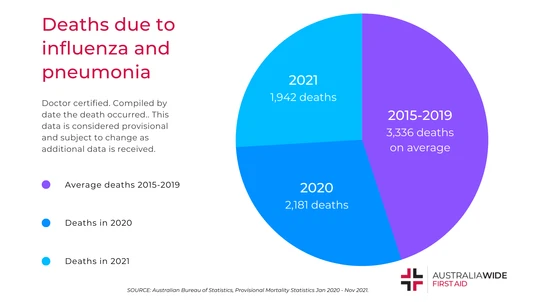
In 2020, just 55 people died from influenza, compared to 1,080 in 2019. There were no deaths due to influenza in November 2021.
Influenza & Pneumonia
Influenza is a viral infection and a common cause of pneumonia. Pneumonia can be caused by a virus, bacteria or fungi. Both are acute respiratory diseases. Between January and November 2021, there were 1,967 deaths due to influenza and pneumonia. All but 2 were due to pneumonia. This number is 34 deaths (1.7%) lower than the same period in 2020, and 1,167 deaths (37.2%) lower than the 2015-19 average. There was a decrease of more than 20% in influenza and pneumonia as an associated cause of death (where it was not the underlying cause of death). Influenza deaths are seasonal, most commonly between May and September in Australia. From year to year, flu season varies in its timing, length and severity. In 2020, just 55 people died from influenza, compared to 1,080 in 2019. There were no deaths due to influenza in November 2021. Commenting on these low numbers, Professor Ian Barr, deputy director of the WHO Collaborating Centre for Reference and Research on Influenza, said, "You have to do exceptional things like having very, very high vaccination rates or doing something dramatic like [what is] currently happening with a severe lockdown type of approach." Between January and November 2021, there were 1,965 deaths due to pneumonia - 22.5% below the 2015-19 average but comparable to 1,958 deaths during the same period in 2020. During November 2021 there were 134 pneumonia deaths - 8.1% more than in November 2020 but 35.3% below the 2015-19 average. Pneumonia deaths have generally been at below average numbers since late April 2020.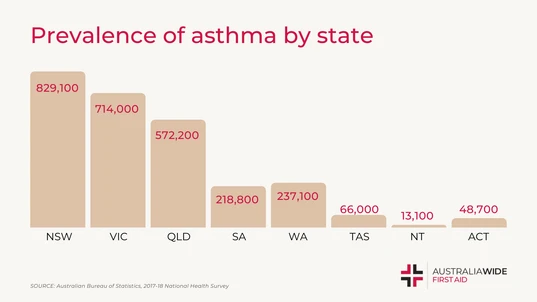
Asthma
Asthma is a common chronic condition that narrows the airways and causes wheezing, breathlessness and chest tightness. It can affect people of all ages. Asthma was the 10th largest cause of disability-adjusted life years (DALYs) and the 5th largest cause of non-fatal disease burden, according to the 2015 Australian Burden of Disease Study.Prevalence of asthma
The prevalence of asthma has increased over the last 10 years, from 9.9% in 2007-08 to 11.2% in 2017-18. The 2017–18 National Health Survey showed 2.7 million Australians had asthma – 11.2% or 1 in 9 – based on self-reported data from the Australian Bureau of Statistics. It's more common in females (12.3%) than in males (10.2%), especially among those aged 30 and over. Among those aged 0–14, asthma was more common among boys aged 0-14 years (12.1%) than girls (7.9%), with this pattern being consistent since 2001. In males and females aged 15–29, the prevalence of asthma was not significantly different.Socioeconomic factors
Asthma occurred highest in the lowest socioeconomic areas compared with those living in the highest areas – males: 13% and 10%, respectively; females: 16% and 10%, respectively. The prevalence of asthma in males was similar across remoteness areas. However, among females, it was more prevalent among those living in Outer regional areas (15%), compared with those living in Major cities (11%). According to the ABS 2012–13 Australian Aboriginal and Torres Strait Islander Health Survey, Indigenous Australians were almost twice as likely to have asthma (19%) compared with non-Indigenous Australians (10%).Asthma medication
Medication is used by 32.8% of people with asthma to help manage the symptoms of asthma daily. One in 6 (17.3%) used medication a few times a week; while two in 5 people (41.0%) went without medication for more than two weeks. Just under half of children under the age of 18 (48.1%) and just over three in five adults (61.4%) with asthma, took medication in the last two weeks. The National Asthma Council Australia recommends every asthma sufferer, adult and child, have their own personalised asthma action plan. Among those under the age of 18 years, only 62.9% had asthma action plans. And only 23.2% of those aged 18 years and over had a written asthma action plan. Adult women were more likely (25.7%) to have a written action plan than adult men (19.6%).COPD – Chronic Obstructive Pulmonary Disease
Chronic obstructive pulmonary disease is a preventable and treatable lung disease that interferes with normal breathing and is not fully reversible. COPD typically causes phlegm, coughing, and/or dyspnoea (difficult or laboured breathing), usually worsening over time. According to the WHO, COPD symptoms often don't appear until significant lung damage has occurred. The symptoms of COPD can be difficult to distinguish from asthma. Both conditions are chronic inflammatory diseases that cause obstruction to the airways (Buist 2003). Although the two diseases present several common characteristics, they have different clinical outcomes.What causes COPD?
COPD is the result of interactions between genes and the environment. There are many causes of COPD, according to the Global Initiative for Chronic Obstructive Lung Disease (GOLD), including:- Tobacco smoking – both active and passive smoking. Epidemiologic studies consistently show evidence of non-smokers developing chronic airflow limitation.
- Genetic factors – a form of emphysema can occur when the body has trouble producing one of the proteins (Alpha-1 antitrypsin) that protects the lungs. Lacking this protein, a person can be more susceptible to COPD and other lung diseases.
- Lung growth and development factors – any developmental factors affecting the lungs during gestation and childhood, such as abnormal lung growth, low birthweight, and early childhood lung infections, can increase the risk of developing COPD (Lange et al. 2015).
- Environmental factors – working or living in areas where there is dust, gas, chemical agents and fumes, smoke or air pollution.
Who gets COPD?
Developing over many years, COPD mainly affects people aged 45 and over. The prevalence of COPD (as self-reported emphysema and/or bronchitis) in the 2017–18 ABS National Health Survey, was 4.8% of Australians 45 years and over, or an estimated 464,000 people (ABS 2018). There was no significant difference in COPD prevalence between men and women – 4.5% and 5.1% respectively. However, in the 55-64 age group, COPD was more prevalent in women (6.2%) compared with men (3.6%). A health survey is not a reliable way to determine the prevalence COPD. Formally defined as an abnormality of lung function, clinical testing is required to accurately determine the presence of COPD. An international study in 2007 – the Burden of Obstructive Lung Disease – tested the lung function of nearly 10,000 people. This BOLD study estimated the prevalence of COPD to be 10% for people aged 40 and over in 12 countries, including Australia, China, Turkey, Iceland, Germany, USA and Canada. A later study in Australia, using similar protocols, estimated the prevalence of COPD as 7.5% for people aged 40 years and over and 30% for people aged 75 and over (Toelle et al. 2013).Australian life expectancy
Overall, the news is good in terms of life expectancy for Australians – our life expectancy has been increasing over the years. It has been improving at a faster rate for men than it has for women and, as a result, the gap has narrowed between the life expectancies of males and females.Sources
- 2017–18 ABS National Health Survey
- Global Initiative for Chronic Obstructive Lung Disease (GOLD)
- Australian Institute of Health and Welfare
- Australian Burden of Disease Study: impact and causes of illness and death in Australia 2015
- ABS 2012–13 Australian Aboriginal and Torres Strait Islander Health Survey
Originally published at
https://www.australiawidefirstaid.com.au/resources/chronic-respiratory-conditions
as part of the Australia Wide First Aid Articles Library


